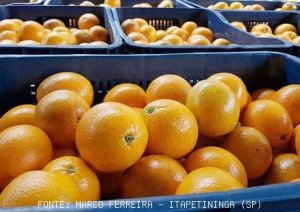 See photos
See photos
Piracicaba, 06 – The availability of late oranges from the 2018/19 crop increased in São Paulo State in October – valencia orange has been traded since mid-August and the harvesting of natal oranges started in September.
At processors, orange crushing was in full swing last month – while the delivery of early oranges ended, late oranges have been purchased since August, mainly because of the low pear orange supply this year, due to the weather.
Spot prices for processors were stable in October. At large-sized processors, oranges, both pear and late, were traded at up to 24 BRL per 40.8-kilo box, harvested and delivered. According to Hortifruti/Cepea collaborators, the weather had lower effects on late than on pear oranges. Thus, late orange supply was slightly higher.
IN NATURA MARKET – Rains in October allowed farmers to start harvesting pear oranges out of the ideal period, aiming to prevent the current low inventories in São Paulo State from decreasing more – and also to take advantage of the firm price levels.
However, according to Cepea collaborators, demand was still low in October, since purchasers were trying not to buy oranges at high price levels – in some cases, opting for lower quality fruits. Between October 1 and 31, pear orange quotes averaged 32.83 BRL per 40.8-kilo box, on tree, 4.6% up compared to that in September.
JUICE EXPORTS – The amount of Frozen Concentrate Orange Juice (FCOJ) exported this season (July to September/18) is already lower than that in the same period last year. This scenario may be linked to both expectations for a higher supply in the United States and the strategy of some processors from São Paulo State to reduce the volumes shipped this crop, aiming to prevent inventories from decreasing to critical levels in June 2019.
Production in the citrus belt should decrease by 31.4% in the 2018/19 season compared to the previous crop, totaling only 273.3 million 40.8-kilo boxes of oranges, according to Fundecitrus (Citrus Defense Fund). Thus, inventories in the 2018/19 crop should again decrease to critical volumes by June 2019, as CitrusBR (Brazilian Association of Citrus Exporters) predicted in August, totaling only 146.7 thousand tons of juice – enough for two months of exports, at the most.
According to Secex, Brazilian FCOJ shipments to all destinations have totaled 235.5 thousand tons this crop (July to September/18), 23% down compared to the previous season. Revenue has dropped 17% in the same comparison, to 445.43 million USD.
However, some of the agents from processors affirm not to be reducing the amounts exported this season. Thus, this scenario may also be linked to the lower global demand.
Brazilian FCOJ exports to the United States between July and September 2018 decreased 40% compared to the same period of 2017, totaling 44.6 thousand tons. To the European Union, Brazilian shipments totaled 156.6 thousand tons of FCOJ, 22% down compared to the previous season.
DEMAND FOR JUICE – Even if the processors from SP reduce orange juice exports during the season – and supply from the United States really increases in 2018/19 –, the demand from the USA for the Brazilian orange juice should keep high. Although greening has been better controlled in Florida, it is still a long-term issue. Besides, positive estimates should not result in a sharp increase at American processors inventories.
Source: hfbrasil.org.br